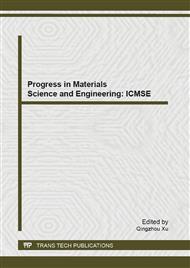p.205
p.212
p.216
p.221
p.227
p.233
p.240
p.246
p.251
Experimental Study and Analysis on Strength Properties of Waste Crumb Rubber Concrete
Abstract:
The experiment program was carried out to investigate strength performance and flexural properties of concrete containing recycled crumb rubber. The rubber contents of 10,20,30 and 40% by volume were selected to partially replace the fine aggregate with crumb rubber of 20 mesh, and sodium hydroxide (NaOH) solution was employed to modify the rubber surface, enhancing adhesion between rubber particles and cement paste. Uniaxial compression and four point bending tests showed that both compressive and flexural strength reduced as crumb rubber inclusion increasing. It is notable that surface modification by NaOH solution have positive effects on strength properties of crumb rubber concrete, and the failure mode tends to become ductile failure due to the rubber inclusion rather than brittle failure of normal concrete.
Info:
Periodical:
Pages:
227-232
Citation:
Online since:
October 2013
Authors:
Price:
Сopyright:
© 2013 Trans Tech Publications Ltd. All Rights Reserved
Share:
Citation:


